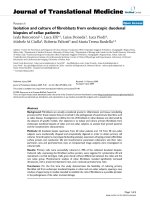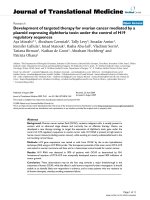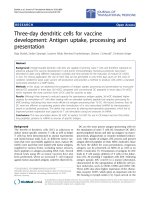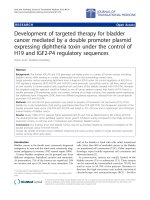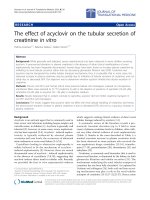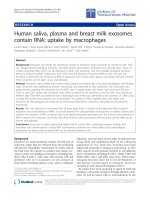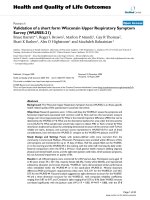Báo cáo hóa học: " Rician nonlocal means denoising for MR images using nonparametric principal component analysis" pdf
Bạn đang xem bản rút gọn của tài liệu. Xem và tải ngay bản đầy đủ của tài liệu tại đây (690.07 KB, 8 trang )
RESEARCH Open Access
Rician nonlocal means denoising for MR images
using nonparametric principal component
analysis
Dong Wook Kim
1
, Chansoo Kim
2
, Dong Hee Kim
1
and Dong Hoon Lim
3*
Abstract
Denoising is always a challenging problem in magnetic resonance imaging (MRI) and is important for clinical
diagnosis and computerized analysis, such as tissue classification and segmentation. The noise in MRI has a Rician
distribution. Unlike additive Gaussian noise, Rician noise is signal dependent, and separating the signal from the
noise is a difficult task. In this paper, we propose a useful alternative of the nonlocal mean (NLM) filter that uses
nonparametric principal component analysis (NPCA) for Rician noise reduction in MR images. This alternative is
called the NPCA-NLM filter, and it results in improved accuracy and computational performance. We present an
applicable method for estimating smoothing kernel width parameters for a much larger set of images and
demonstrate that the number of principal components for NPCA is robust to variations in the noise as well as in
images. Finally, we investigate the performance of the proposed filter with the standard NLM filter and the PCA-
NLM filter on MR images corrupted with various levels of Rician noise. The experimental results indicate that the
NPCA-NLM filter is the most robust to variations in images, and shows good performance at all noise levels tested.
Keywords: image denoising, magnetic resonance (MR) image, nonlocal means (NLM), nonpa rametric principal
component analysis (NPCA), Rician noise
1 Introduction
Magnetic resonance (MR) images are affected by several
types of artifact and noise sources, such as random fluc-
tuations in the MR s ignal mainly due to the thermal
vibrations of ions and electrons. Such noise markedly
degrades the a cquisition of quantitative measurements
from the data. The noise in MR images obeys a Rician
distributi on [1-3]. Unlike additive Gaussian noise, Rician
noise is signal dependent, and consequently separating
the signal from the noise is difficult.
There is an extensive literature on Rician noise reduc-
tion in magnet ic resonance imaging (MRI), varying from
the use of traditional smoothing filters to more elegant
methods. Most conventional mask-based denoising filters,
such as Gauss ian and Wiener filters [4], are conceptually
simple. However, they will most likely fail to reduce Rician
noise in MRI, as they usually assume that the noise is
Gaussian. Restored images may often look blurred and
may be corrupted by artifacts t hat are usually visible
aroun d the edges. One way to overcome the pro blems of
simple smoothing is to use a nonlocal means (NLM) filter
[5-10]. These methods make u se of the self-similarity of
images, in that many structures show up more than once
in the image. The NLM filter takes advantage of the high
degree of redundancy of any natural image and produces
an optimal denoising result if the noise can be modeled as
Gaussian. Unfortunately, the method requires computa-
tion of the weighting terms for all possible pairs of pixels,
making it computationally expensive. A number of recent
reports on NLM denoising focused on shortcuts to make
the method computationally practical [11-14]. One of the
most compelling strategies is to exclude many weight
computations between the image neighborhood feature
vectors.Azzabou,etal.[11]andTasdizen[13,14]pro-
posed the so-called PCA-NLM filter, which uses the lower
dimensional subspace of the space of image neighborhood
vectors in conjunction with NLM using principal compo-
nent analysis (PCA). More im portant, this approach was
* Correspondence:
3
Department of Information Statistics and RINS, Gyeongsang National
University, Jinju 660-701, Korea
Full list of author information is available at the end of the article
Kim et al. EURASIP Journal on Image and Video Processing 2011, 2011:15
/>© 2011 Kim et al; licensee Springer. This is an Open Access article d istributed under the terms of the Creative Commons Attribution
License (http:/ /creativecommons.org/licenses/by/2.0), which permits unrestricted use, distribution, and reproduction in any medium,
provided the origina l work is properly cited.
also shown to result in increased accuracy over those that
use the full-dimensional ambient space.
There are, however, some applications for which the
PCA-NLM filter is not recommended because PCA is
sensitive to image features and the presence of noise in
the data, and the PCA-NLM filter is, therefore, highly
dependent on the settings of its parameters.
In this paper, we propose a nonparametric PCA-NLM
filter that is a useful alternative to the PCA-NLM filter
for Rician noise reduction in MR images. The proposed
filter uses PCA with ranked data instead of the original
pixel data. We refer to this as the NPCA- NLM filter.
We estimate t he subspace dimensionality from par allel
analysis [15-17] based on the artificial rank correlation
matrix. In contrast to the method reported by Tasdizen
[13,14], our estimation does not r equire the assumption
of a Gaussian distribution and produces a more robust
subspace dimensionality regardless of the images being
denoised. We also propose a nonparametric method for
optimal smoothing kernel width selection.
2 Background
2.1 Rician noise in MRI
In MRI, raw data are intrinsically complex valued and
corrupted with zero mean Gaussian distributed noise
with equal variance [1]. MR magnitude images are
formed by simply taking the square root of the sum of
the square of the two independent Gaussian random
variables (real and imaginary images) pixel by pixel. After
this nonlinear transformation, MR magnitude data can
be shown to have a Rician distribution [1-3,9,18]. For an
MR magnitude image, the Rician probability density
function of the measured pixel intensity x is given by
p(x|A)=
x
σ
2
exp
−
x
2
+ A
2
2σ
2
I
0
A · x
σ
2
,
(1)
where I
0
is the modified zeroth-order Bessel function
of the first kind, A is the underlying noise-free signal
amplitude, and s denotes the standard deviation of the
Gaussian noise in the real and imaginary images . When
A/s is high, the Rician distribution approaches a Gaus-
sian; when A/s approaches 0, i.e., when only noise is
present, the R ician distribution b ecomes Rayleigh dis-
tributed and Equation 1 reduces to [1]
p(x|A)=
x
σ
2
exp
−
x
2
2σ
2
.
2.2 NLM filter
Starting from a true, discrete image u, a noisy observa-
tion of u at pixel i is defined as υ(i) = u(i) + n(i).Let
N
i
and
v
(
N
i
)
denote a square n eighborhood centered
around pixel i and the image neighborhood vector, the
elements of which are the gray-level values of υ at
N
i
,
respectively. Also, let S
i
be a square search-window of
fixed size centered around pixel i. Then, the NLM filter
[5,6] defines an estimator for u(i) as
ˆ
u(i)=
j
∈S
i
1
Z
i
exp
−
v(
N
i
) − v(N
j
)
h
2
2
υ(j)
,
(2)
where Z
i
is a normalization constant and h acts as a
smoothing parameter controlling the decay of the expo-
nential function.
This method is too slow to be practical. The hig h
computational complexity is due to the cost of weight
calculation for all pixels in the image during the process
of denoising. For every pixel being processed, the whole
image is searched and the differences between corre-
sponding neighborhoods computed.
3 Proposed NPCA-NLM denoising
3.1 NPCA approach
We include a brief description of the projections of the
image neighborhood vectors onto a lower dimensional
space by NPCA, which uses their ranks instead of the
original data. Let Ω denote the entire set of pixels in
the image and let Ψ bearandomlychosensubsetofΩ.
Also, let R
i
denote the rank vector of {x
i
, i =1, ,Q}in
each window of Q size, where Q=r× r. The principal
components of Q rank vector can be obtained from the
eigenvectors of the rank covariance matrix
C
R
=
1
||
i
∈
(R
i
−
¯
R)(R
i
−
¯
R)
T
,
(3)
where
¯
R =(1/||)
i
∈
R
i
is the rank mean and |Ψ|
is the number of elements in the set Ψ.Let{e
p
: p =
1, ,Q} be the eigenvectors of C
R
, i.e., the principal
neighborhoods, sorted in order of descending eigenva-
lues. Let the d-dimensional NPCA subspace be the
space spanned by {e
p
: p = 1, , d}. Then, the projection
of the image neighborhood vectors onto d-dimensional
NPCA subspace is
R
d
i
=
d
p
=1
(R
i
◦ e
p
)e
p
,
where (R
i
◦ e
p
) denotes the inner product of the two
vectors.
Let
f
d
i
=[(R
i
◦ e
1
), ··· ,(R
i
◦ e
d
)]
T
be the d-dimen-
sional vector of projection coefficie nts. Then, beca use of
the orthonormality of the basis
R
d
i
− R
d
j
2
=
f
d
i
− f
d
j
2
.
Kim et al. EURASIP Journal on Image and Video Processing 2011, 2011:15
/>Page 2 of 8
Then, the d-dimension NLM algorithm in NPCA
space is
ˆ
u
d
(i)=
j∈S
i
1
Z
d
i
exp
⎛
⎜
⎝
−
f
d
i
− f
d
j
2
h
2
⎞
⎟
⎠
υ(j)
,
(4)
where
Z
d
i
=
j
∈S
i
e
−
f
d
i
−f
d
j
2
/h
2
is the new normalizing
term. Note that the proposed approach with d=Qis
equivalent to the useful NLM filter when applied to
ranks rather than the original observations, i.e., Equation
4withd=Qbecomes Equation 2 when calculated on
the ranks.
3.2 Optimal smoothing parameter selection
Given a noisy image and a combin ation of
N
and d,
there exists an optimal choice of the parameter h in
Equation 3.2 that yields the best output in terms of peak
signal-to-noise ratio (PSNR). Figure 1 shows the PSNR
of the estimator output û
d
as a function of h for an
image corrupted with Rician noise (s= 30).
Buades et al. [5,6] reported that the smoothing para-
meter h depends on the standard deviation of the noise
s, and typically a good choice for 2D images is h ≈ 10s.
Tasdizen [14] used simple linear regression based on
the least squares method as an automatic way of choos-
ing h givenanimageneighborhoodsizeandsubspace
dimensional ity size. Working under the no rmality
assumption, he achieved a reasonable applicable rule for
parameter selection. If the pixel values are not normally
distributed, then h in [14] may not be optimal. In prac-
tice, the choice of h that is applicable in situations
where the normal procedures cannot be utilized may be
appropriate. We take as our model
h = β
(
r, d
)
σ + α
(
r, d
)
+ ∈,
where b(r, d) and a(r, d) are unknown parameters and
Î is an independent and identically distrib uted random
variable with an arbitrary continuous distribution f unc-
tion F. We use a nonparametric method [19] for the lin-
ear regression problem as an automatic way of choosing
h givenanimageneighborhoodsizeandd.Table1
shows the line ar fit parameters for several choices of d
of 7 × 7 image neighborhoods. Parameters such as those
shown in Table 1 can be precomputed for all
N
and d
of interest.
Unlike Tasdizen [14], the linear fit parameters in
Table 1 do not require the assumption of a Gaussian
distribution of th e noise with which the images are cor-
rupted. Therefore, we expect that h produced by these
parameters will yield results for a much larger set of
images than that from which they were learned.
3.3 Automatic dimensionality selection
Determining the number of components to retain is a
crucial problem when using PCA. Of several methods
proposed for determining the significance of principal
components, the K1 method pro posed by Kaiser [20] is
the best known and most commonly utilized in practice
[21]. However, this method often overextracts compo-
nents [22]. Another commonly used approach is based
on Cattell’ s Scree test [23], which involves the visual
exploration of a graphical represent ation of the eigenva-
lues. This method has been criticized for its subjectivity,
as there is no objective definition of the cutoff point
between the important and trivial factors. Parallel analy-
sis [15] is more accurate than the above methods for
determining the number of retained components, but it
tends to overextract components [22]. Tasdizen [14]
proposed a modification of the parallel analysis algo-
rithm for determining the number of components in
PCA of image neighborhoods for denoising. One of the
main drawbacks of parallel analysis is that the number
of principal c omponents to retain is highly dependent
on the images and the noise. Therefore, different num-
bers of principal components are required for images
with different features . A quick solution to this problem
is to use a modified procedure for parallel analysis of
ranked data. Let l
p
for 1 ≤ p ≤ Q denote the eigenvalues
of C
R
in Equation 3 sorte d in descending order. Simi-
larly, let a
p
denote the sorted eigenvalues of the artificial
Figure 1 PSNR as a function of the parameter h for the brain
image.
Table 1 Slope and intercepts used in determining h for
various subspace dimensionality of 7 × 7 neighborhoods
d=6 d=10 d =20 d =49
Slope (b) 2.2 2.37 3.275 4.55
Intercept (a) 4 21.75 26.375 40.125
Kim et al. EURASIP Journal on Image and Video Processing 2011, 2011:15
/>Page 3 of 8
rank covariance matrix. Parallel analysis estimates data
dimensionality as
d =max({1 ≤ p ≤ Q|λ
p
≥ α
p
})
.
Figure 2 shows the automatic dimensionality selection
results for brain, body,andknee images w ith noise s
ranging from 5 to 50 in increments of 5. The numbers
of significant components for PCA as shown in Figure 2
were computed as about 10, 14, and 16 for brain, body,
and knee images, respectively; however, the numbers of
sig nificant components for NPCA were all computed as
about15.Itisimportanttonotethatthenumbersof
components vary more significantly with noise levels for
PCA than for NPCA. Therefore, the number of principal
components for NPCA is more robust to variations in
noise as well as in images than for PCA.
Figure 3 shows the PSNR of the estimator output û as
afunctionofd for a brain image that was corrupted
with Rician nois e(s = 10). The c urve for PCA showed a
steep increase until the peak d, for example, d=15,
after which the curve declined significantly. In contrast,
the curve for NPCA increased similarly until the peak
point, after which it became considerably flat. Therefore,
as expected, the incorrect determination of the number
of components for PCA can result in remarkable PSNR
loss.
4 Experiments and results
The proposed NPCA-NLM filter was test ed using 256 ×
256, 8-bits/pixel MR images, i.e., the brain, body,and
knee images shown in Figure 4. The performance of the
proposed filter was tested for various levels of noise cor-
ruption and compared with the standard NLM filter and
recently proposed PCA-NLM filter.
We generated MR magnitude data by adding Rician
noise to noise-free images. The Rician noise was created
as
y
e
(t
i
)=
[y(t
i
)+e
1
]
2
+ e
2
2
,
,wherey isthetruesignal
and e
1
and e
2
are random numbers from a Gaussian dis-
tribution with zero mean and standard deviation s [9].
Four levels of noise were tested with s = [10, 20, 30,
40]. Figure 5 shows close-up images of the test images
in Figure 4, which were corrupted with Rician noise s =
10 and 40.
In addition to the visual quality, the performance of
the proposed filter was measured by the following cri-
teria: PSNR, mean absolute error (MAE ), and structural
dissimilarity (DSSIM). For 8-bit images, PSNR and MAE
are defined as follows:
PSNR = 10 · log
10
⎡
⎢
⎣
255
2
1
MN
M−1
i=0
N−1
j=0
I(i, j) −
ˆ
I(i, j)
2
⎤
⎥
⎦
,
MAE =
1
MN
M−1
i=0
N−1
j
=0
I(i, j) −
ˆ
I(i, j)
,
where Î(i,j) and I(i,j) denote the pixel values of the
restored image and the original image, respectively, at
location (i,j) and M × N is the size of the image. Higher
PSNR values indicate better restoration, and smaller
MAE values indicate that the filter can preserve more
details and edges. However, they were not very well
(
a
)
PCA-NLM
(
b
)
NPCA-NLM
Figure 2 Optimal dimension d as a function of the Rician noise for three MR images.
Kim et al. EURASIP Journal on Image and Video Processing 2011, 2011:15
/>Page 4 of 8
matched to perceived visual quality. DSSIM is a distance
metric derived from structural similarity (SSIM), which
takes into account the human visual system, and was
defined as follows [24]:
DSSIM(x , y)=
1
1 − SSIM
(
x, y
)
,
where SSIM is given by
S
SIM(x, y)=
(2μ
x
μ
y
+ c
1
)(2cov
xy
+ c
2
)
(μ
2
x
+ μ
2
y
+ c
1
)(σ
2
x
+ σ
2
y
+ c
2
)
,
where μ
x
and μ
y
are means of x and y, respectively;
σ
2
x
and
σ
2
y
are variances of x and y, respectively; and cov
xy
is covariance of x and y. The constants w ere set as fol-
lows: c
1
= 0.01L and c
2
=0.03L,andL was 255 for 8-
bits/pixel gray scale images.
4.1 Visual quality comparison
Figures 6 and 7 show the results of applying the three
filters to noisy images corrupted with Rician noise s =
10 in Figure 5a-c, and Rician no ise s = 40 i n Figure 5d-
f, respectively.
As shown in F igure 6, the thre e filters based on the
NLM filter performed well on images with low noise
variance ( s = 10). The differences in performance of
these filters are difficult to distinguish in the restored
images for low noise, but inspection of images with
high noise in Figure 7 showed that the denoising
effects of the NPCA-NLM filter and PCA-NLM filter
were almost identical, except for slight blurring of the
output from the PCA-NLM filter. However, the impact
of noise on the standard NLM filter was clearly visible,
and the restored images cont ained considerable noise
spots.
4.2 Quantitative comparison
The quantitative performances in terms of PSNR,
MAE, and DSSIM for all of the algorithms are given in
Tables 2, 3, and 4, respectively. The r esults shown in
these tables indicate that t he NPCA-NLM filter had
the best performance among the filters examin ed for
the brain image over all noise ranges s = 10, 20, 30,
40. The NPCA-NLM filter showed better performance
than the NLM filter and PCA-NLM filter for body and
knee images, which were corrupted with s =10and
40. It should be noted that the performance gap
between the NPCA-NLM filter and the PCA-NLM fil-
ter increased on images with high noise. This was
expected, as the PCA-NLM filter is more sensitive to
noise. Our filter with the PCA-NLM filter still showed
good performance on images that were c orrupted with
s = 20 and 30.
Figure 3 PSNR as a function of the parameter d.
(
a
)
brain image
(
b
)
body image
(
c
)
knee image
Figure 4 Test images.
Kim et al. EURASIP Journal on Image and Video Processing 2011, 2011:15
/>Page 5 of 8
(a) brain image with σ=10 (b) body image with σ=10 (c) knee image with σ=10
(
d
)
brain image with σ=40
(
e
)
body image with σ=40
(
f
)
knee image with σ=40
Figure 5 Close-up images corrupted by Rician noise.
(a) NLM (b) PCA-NLM (c) NPCA-NLM
(d) NLM (e) PCA-NLM (f) NPCA-NLM
(
g
)
NLM
(
h
)
PCA-NLM
(
i
)
NPCA-NLM
Figure 6 Comparison of the restoration on corrupted images in Figure 5a-c.
Kim et al. EURASIP Journal on Image and Video Processing 2011, 2011:15
/>Page 6 of 8
Of the three filters investigated, the NPCA-NLM fil-
ter appeared to be the most robust to variations in
images, performing well at all noise distributions
tested.
5 Conclusion
We proposed an NPCA-NLM filter, which is a useful
alternative to the PCA-NLM filter for Rician noise
reductioninMRimages.ThefilterusesPCAwith
(a) NLM (b) PCA-NLM (c) NPCA-NLM
(d) NLM (e) PCA-NLM (f) NPCA-NLM
(
g
)
NLM
(
h
)
PCA-NLM
(
i
)
NPCA-NLM
Figure 7 Comparison of the restoration on corrupted images in Figure 5d-f.
Table 2 PSNR values for various Rician noise levels
s = 10 s =20 s =30 s = 40
Brain image
NLM 32.62 27.39 23.26 20.10
PCA-NLM 32.64 27.29 23.61 20.47
NPCA-NLM 32.84 27.63 23.65 20.48
Body image
NLM 31.94 25.07 20.78 17.80
PCA-NLM 31.94 25.13 20.93 17.87
NPCA-NLM 32.08 25.08 20.94 17.96
Knee image
NLM 31.80 27.99 24.43 21.43
PCA-NLM 32.13 28.17 24.66 21.82
NPCA-NLM 32.31 28.25 24.62 21.86
Table 3 MAE values for various Rician noise levels
s =10 s = 20 s = 30 s = 40
Brain mage
NLM 4.42 9.03 14.62 21.04
PCA-NLM 4.40 9.07 14.09 20.06
NPCA-NLM 4.29 8.88 14.02 20.03
Body image
NLM 5.06 12.65 20.97 29.62
PCA-NLM 5.06 12.59 20.63 29.35
NPCA-NLM 4.99 12.64 20.65 29.11
Knee image
NLM 4.93 7.98 11.84 16.66
PCA-NLM 4.77 7.82 11.46 15.66
NPCA-NLM 4.70 7.78 11.58 15.59
Kim et al. EURASIP Journal on Image and Video Processing 2011, 2011:15
/>Page 7 of 8
ranked data instead of the original pixel data. The image
neighborhood vectors used in the NLM filter are pro-
jected onto a lower dimensional subspace using NPCA.
Therefore, the lower dimensional projections are not
only used as search criteria, but also for computing
similarity weights resulting in better accuracy in addi-
tion to reduced computational cost.
We estimated the subspace dimensionality from paral-
lel analysis based on the artifi cial rank correlation
matrix. We demonstrated that the numbers of compo-
nents varied more significantly with noise level for PCA
than for NPCA. Therefore, the number of principal
components was more robust to variations in the noise
as well as in the images for NPCA than for PCA. We
also proposed a nonparametric method for optimal
smoothing kernel w idth selection that produces results
foramuchlargersetofimagesthanthatfromwhich
they were learned.
We investigated the performance of the proposed fil-
ter in compar ison with the standard NLM filter and the
recently proposed the PCA-NLM filter for various levels
of Rician noise corruption. The experimental results
showed that the NPCA-NLM filter was the most robust
to variations in images, performing well at all noise
levels tested.
Acknowledgements
This work was supported by the RACS 2010-2014, Production of fine-scale
scenario of future climate change using regional climate models and
analysis of uncertainties.
Author details
1
Department of Statistics, Busan National University, Busan, Korea
2
Department of Applied Mathematics, Kongju National University, Gongju,
Korea
3
Department of Information Statistics and RINS, Gyeongsang National
University, Jinju 660-701, Korea
Competing interests
The authors declare that they have no competing interests.
Received: 7 February 2011 Accepted: 14 October 2011
Published: 14 October 2011
References
1. Gudbjartsson H, Patz S: The Rician distribution of noisy MRI data. Magn
Reson Med 1995, 34(6):910-914.
2. Macovski A: Noise in MRI. Magn Resonance Med 1996, 36(3):494-497.
3. Nowak RD: Wavelet-based Rician noise removal for magnetic resonance
imaging. IEEE Trans Image Process 1999, 8(10):1408-1419.
4. Khireddine A, Benmahammed K, Puech W: Digital image restoration by
Wiener filter in 2D case. Adv Eng Softw 2007, 38:515-516.
5. Buades A, Coll B, Morel JM: A review of image denoising algorithms, with
a new one. Multiscale Model Simul 2005, 4(2):490-530.
6. Buades A, Coll B, Morel JM: A non-local algorithm for image denoising.
Proc IEEE Trans IEEE Conf Computer Vision and Pattern Recognition 2005,
60-65.
7. Orchard J, Ebrahim M, Wang A: Efficient nonlocal-means denoising using
the SVD. Proc Int Conf Image Processing 2008, 1732-1735.
8. Coupe P, Hellier P, Kervann C, Barillot C: NonLocal means-based speckle
filtering for ultrasound images. IEEE Trans Image Process 2009,
18(10):2221-2229.
9. He L, Greenshields IR: A nonlocal maximum likelihood estimation method
for Rician noise reduction in MR images. IEEE Trans Med Imaging 2009,
28(2):165-172.
10. Manjon JV, Coupe P, Mari-Bonmati L, Collins DL, Robles M: Adaptive non-
local means denoising of MR images with spatially varying noise levels.
J Magn Reson Imaging 2010, 31:192-203.
11. Azzabou N, Paragios N, Guichard F: Image denoising based on adapted
dictionary computation. Proc Int Conf Image Processing 2007, III:109-112.
12. Coupe P, Yger P, Prima S, Hellier P, Kervrann C, Barillot C: An Optimized
blockwise nonlocal means denoising filter for 3-D magnetic resonance
images. IEEE Trans Med Imaging 2008, 27(4):425-441.
13. Tasdizen T: Principal components for non-local means image denoising.
Proc Int Conf Image Processing 2008, 1728-1731.
14. Tasdizen T: Principal neighborhood dictionaries for nonlocal means
image denoising. IEEE Trans Image Process 2009, 18(12):2649-2660.
15. Horn JL: A rationale and test for the number of factors in factor analysis.
Psycho-metrica 1965, 30(2):179-185.
16. Glorfeld LW: An improvement on horn’s parallel analysis methodology
for selecting the correct number of factor
’s to retain. Educ Psychol Meas
1995, 55(3):377-393.
17. Ledesma RD, Valero-Mora P: Determining the number of factors to retain
in EFA:an easy-to-use computer program for carrying out parallel
analysis. Practical Ass Res Eval 2007, 12(2):1-11.
18. Sijbers J, den Dekker AJ, Scheunders P, Dyck DV: Maximum-likelihood
estimation of Rician distribution parameters. IEEE Trans Med Imaging
1998, 17(3):357-361.
19. Sen PK: Estimates of regression coefficient based on Kendall’s tau. JAm
Stat Assoc 1968, 63:1379-1389.
20. Kaiser HF: The application of electronic computers to factor analysis.
Educ Psychol Meas 1960, 20:141-151.
21. Fabrigar LR, Wegener DT, MacCallum RC, Strahan EJ: Evaluating the use of
exploratory factor analysis in psychological research. Psychol Methods
1999, 3:272-299.
22. Zwick WR, Velicer WF: Comparison of five rules for determining the
number of components to retain. Psychol Bull 1986, 99:432-442.
23. Cattell RB: The scree test for the number of factors. Multivar Behav Res
1966, 1:245-276.
24. Wang Z, Bovik AC, Sheikh HR, Simoncelli EP: Image quality assessment:
From error visibility to structural similarity. IEEE Trans Image Process 2004,
13(4):600-612.
doi:10.1186/1687-5281-2011-15
Cite this article as: Kim et al.: Rician nonlocal means denoising for MR
images using nonparametric principal component analysis. EURASIP
Journal on Image and Video Processing 2011 2011:15.
Table 4 DSSIM values for various Rician noise levels
s =10 s = 20 s = 30 s = 40
Brain image
NLM 287.2 88.4 35.12 17.17
PCA-NLM 288.6 85.1 38.21 18.75
NPCA-NLM 302.7 93.2 38.66 18.81
Body image
NLM 304.0 59.5 22.35 11.55
PCA-NLM 303.9 60.2 22.96 11.58
NPCA-NLM 313.9 59.5 23.01 11.84
Knee image
NLM 236.7 98.8 44.64 22.59
PCA-NLM 255.9 103.3 47.18 24.97
NPCA-NLM 266.4 105.4 46.83 25.20
Kim et al. EURASIP Journal on Image and Video Processing 2011, 2011:15
/>Page 8 of 8

